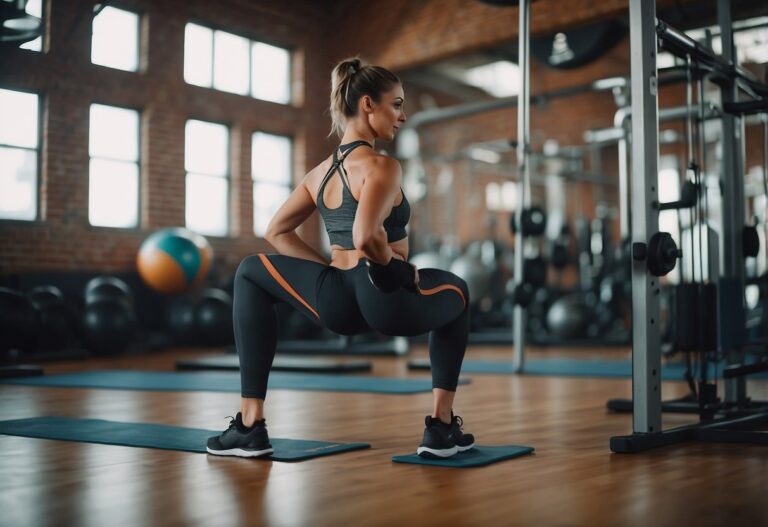Are you looking to spice up your fitness routine with something new and effective? Rope workouts are a fantastic way to boost your cardio, build strength, and improve your coordination. Whether you’re new to fitness or a seasoned athlete, incorporating rope exercises can offer a refreshing challenge and versatile workout option.

Why should you consider adding rope workouts to your fitness regime? They not only provide an intense cardiovascular workout but also engage multiple muscle groups at once. With a variety of movements and techniques, you can keep your exercises dynamic and fun, ensuring you stay motivated and on track with your fitness goals.
Double Unders
Double unders are a great way to take your rope workout to the next level. Instead of the rope passing under your feet once, it goes under twice with each jump. This requires quick wrist movement and a higher jump.
When starting, focus on mastering the power jump. This is a higher jump than your usual one. Practise this without using the rope at first.
Keep your body tight. Squeeze your abs and glutes, and keep your legs together. This helps with control and efficiency. Use your wrists to spin the rope, not your arms.
Speed cable ropes are often the best choice. They have steel cables and 90-degree handles for better momentum. Find a rope that suits your speed and comfort. Happy jumping!
Criss-Cross Jumps
Mastering criss-cross jumps can take your rope workouts to the next level. To start, keep the rope behind you with both hands on the handles. Position your arms apart and pull them slightly forward.
Next, as you swing the rope over your head, cross your arms at the elbows. Jump through the loop created by the crossed rope. Timing is crucial, so practice the arm-cross motion without jumping first.
For better results, introduce this move gradually. You can also try variations like speed criss-cross or single-leg criss-cross for added challenge. These can make your workouts more intense and engaging.
Boxer Step
The boxer step is a fundamental technique in rope workouts.
Start by standing with your feet shoulder-width apart. Keep a slight bend in your knees, and shift your weight from one foot to the other as you jump.
Timing and rhythm are crucial. Imagine you’re bouncing on the balls of your feet, almost like a light dance.
Think of the rope as an extension of your body. Use small wrist movements to swing it in a smooth, circular motion.
Once you get the hang of it, try adding variations like high knees. This will keep your workout engaging and effective.
You can find a more detailed guide on how to perfect the Boxer Step on this website.
High Knees
High knees are a great part of any rope workout. They add intensity and work different muscle groups. When you lift your knees high, you’re engaging your core and improving your coordination.
To do high knees with a jump rope, make sure to keep your back straight and your core tight. Use your wrists to turn the rope, not your arms. This helps you stay in control and avoid getting tangled.
Start by jumping at a steady pace and gradually lift your knees higher. It might be tough at first, but with practice, you’ll see improvement. High knees are a fun way to mix up your routine and keep it challenging. For more tips, check out this ultimate beginner’s guide.
Side Swing
The side swing is an excellent move to add to your rope workout. It’s a fun way to transition between jumps and gives you a bit of a breather.
How to Start: Hold the rope handles together, then swing them to your side without jumping. This helps you get the feel for the motion.
Practising the side swing can enhance your coordination. Plus, it’s great for keeping your workout interesting. You might find these tips and tricks useful.
Single Leg Jumps
Single leg jumps are a fantastic way to boost your workout. They help improve your balance and stability while giving your calves a serious workout. Starting with one leg at a time, you only need a rope and a bit of space.
Begin by standing on one leg, keeping the other leg slightly bent. Swing the rope and jump, landing softly on the same foot. Start with short intervals like 20 seconds, resting for 10 seconds before switching legs.
If you are new to single leg jumps, ease into it. Start with just a few reps and gradually increase the time as you build strength and confidence. This method can also enhance your cardiovascular endurance.
Remember, it’s okay to stumble at first. These jumps require practice, but the benefits are worth it. For more tips, you might find the exercises in this jump rope workout for beginners helpful. Happy jumping!
Reverse Jumps
Reverse jumps are a fun twist on the regular jump rope routine. To get started, hold the jump rope handles at your sides with the rope in front of your toes. Rotate your wrists backwards to swing the rope behind you.
As the rope approaches your heels, jump with both feet to let it pass underneath. This movement helps improve coordination and keeps your workouts exciting.
If you’re just starting out, don’t worry if you miss a few jumps. Keep practising, and you’ll see improvement. Incorporating reverse jumps adds variety and challenges your skills in a new way.
Sprint Interval
Sprint intervals are short bursts of intense running followed by rest, helping you build speed and endurance fast. Think of starting with a short sprint of 50 metres at maximum effort. Then, take a short rest of 30-60 seconds.
As you get more comfortable, increase the distance to 100 metres, always pushing yourself. After each sprint, rest again for 30-60 seconds.
If you want a real challenge, try a drill like 200 metres all-out, followed by the same rest period. Remember to warm up properly for about 10 minutes before starting your sprints. Aim for fast and powerful landings to maximise your efforts.
Adding a jump rope could make your workout more fun and impactful.
CrossFit Workout

Rope climbing is a big part of many CrossFit workouts. This challenging exercise boosts upper body strength and improves coordination.
Before you start climbing, it’s important to know the basics. Check out these rope climb drills to get you started right.
Hand grip and footwork are key to success. Practise these techniques regularly to make your climbs smoother and more efficient.
Try incorporating these tips into your routine to enhance your CrossFit experience.
Tabata Interval
Tabata Interval is a high-intensity workout that involves short bursts of intense activity followed by brief rest periods. It was created by Japanese scientist Izumi Tabata in 1996.
In a typical Tabata session, you’ll perform exercises for 20 seconds, then rest for 10 seconds. You repeat this cycle eight times, making up a four-minute workout.
You can use a variety of exercises in a Tabata workout. For example, you might do 20 seconds of rope jumps, rest, then do 20 seconds of burpees. This mix can make the workout more interesting and challenging. Consider trying different combinations to keep things fresh.
Don’t forget to warm up before starting and to cool down afterwards. This helps prevent injury and makes your workout more effective. Are you ready to give Tabata a try?
Benefits of Rope Workouts
Engaging in rope workouts can lead to numerous benefits, including a full-body workout, enhanced cardiovascular health, and increased endurance. These benefits are ideal for people who want an efficient and effective exercise routine.
Full-Body Workout
Rope workouts provide an explosive full-body workout that helps build strength and improve coordination. When you perform exercises like rope slams or waves, you involve multiple muscle groups. Your arms, shoulders, core, and legs all contribute to maintaining stability and power.
Using battle ropes engages your entire body. This dynamic approach means you’re not isolating single muscles but rather working as a cohesive unit. It’s a dynamic, whole-body training method.
The continuous movements also support better neuromuscular coordination. Each exercise demands focus and control, which enhances your mind-body connection. This can be especially beneficial for athletes looking to improve their performance in various sports.
Cardiovascular Health
Rope workouts are also excellent for your heart. They count as a form of high-intensity interval training (HIIT), which alternates periods of intense activity with rest. This style of training elevates your heart rate quickly and efficiently.
Since these workouts are intense and fast-paced, they significantly improve cardiovascular endurance. Heart health is directly impacted by activities that get your blood pumping, and the repeated bouts of exertion followed by brief rests make this type of workout particularly beneficial.
Moreover, the cardio benefits aren’t limited to just heart health. Incorporating exercises such as jump ropes into your routine improves overall stamina and breath control. As you gain endurance, you’ll notice a boost in your energy levels and a reduction in fatigue during other activities.
Increased Endurance
Developing greater endurance is another key benefit of rope workouts. By continually challenging your muscles and cardiovascular system, these exercises push your limits. With regular practice, your body adapts, and your endurance increases.
One aspect of increased endurance is better muscle stamina. Exercises like alternating waves and rope slams require sustained effort from your muscles. Over time, this leads to improved muscle endurance and strength.
Rope workouts also have the advantage of building mental endurance. The challenging nature of these exercises helps you develop focus and resilience, qualities that translate to other areas of life. This mental toughness is a crucial element in pushing through challenging workouts and achieving your fitness goals.
Proper Rope Workout Techniques
To improve your rope workouts, focus on maintaining good posture and hand positioning, while avoiding common mistakes. Following these techniques helps in performing exercises safely and effectively.
Correct Posture
Maintaining proper posture when jumping can make a big difference in your performance. Stand tall with your chest up and back straight. Your feet should be close together to maintain balance. Bend your knees slightly to absorb impact and keep your core engaged to stabilise your movements.
Visualise a string pulling the top of your head upwards, keeping your spine aligned. This helps prevent unnecessary movements that could lead to injuries. Remember to land softly on the balls of your feet to reduce joint stress.
Jumping with correct posture not only improves your efficiency but also minimises the risk of strain and discomfort. Regular practice will make this posture second nature.
Hand Placement and Grip
Proper hand placement and grip are crucial for smooth rope rotation. Hold the handles with a light grip to allow easy wrist movement. Keep your wrists slightly below waist level and your forearms parallel to the floor. Your hands should be positioned equally distant from your hips.
This positioning ensures the rope clears your feet and prevents tripping. Focus on using wrist movements to turn the rope, rather than your arms. This reduces fatigue and improves control.
Palms should face forward, and keep your elbows tucked in close to your body. This technique ensures a consistent and effective rope swing, helping you to maintain a steady rhythm during your workout.
Common Mistakes to Avoid
Awareness of common mistakes can help you refine your technique. One mistake often seen is jumping too high. You only need to clear the rope, so a modest jump is sufficient and less tiring. Another frequent error is using too much arm motion instead of relying on wrist movement.
Avoid keeping your hands too far apart or high above your waist, as this disrupts the rope’s flow and increases the risk of tangling.
Incorrect body posture, like leaning forward, can cause imbalance and strain. Be mindful of landing hard on your heels; instead, aim to land softly on the balls of your feet.
By focusing on these techniques and avoiding common mistakes, you’ll enhance your rope workouts, making them more effective and enjoyable.
Integrating Rope Workouts Into Your Routine
Incorporating rope workouts into your fitness routine can greatly enhance your overall strength and conditioning. By planning sessions effectively, balancing with other exercises, and prioritising recovery, you can maximise the benefits and reduce the risk of injury.
Planning Your Sessions
When planning your rope workout sessions, it’s essential to start with a warm-up to get your muscles ready. Spend about 5-10 minutes doing light cardio and dynamic stretching. This helps increase blood flow and reduces the risk of injury.
Next, decide on the types of rope exercises you will include. Mix basic movements like alternating waves with more advanced ones such as battle rope slams. Create a balanced routine by varying the exercises to target different muscle groups.
It’s also important to schedule your sessions based on your fitness level. Beginners may start with two sessions per week, while more advanced individuals might aim for three to four. Keep the intensity manageable and gradually increase it as your strength and endurance improve.
Balancing with Other Exercises
Balancing rope workouts with other types of exercise ensures a well-rounded fitness regimen. Integrate strength training, cardio, and flexibility exercises into your schedule. This helps to prevent overuse injuries and promotes overall muscle balance.
For instance, alternate between rope workouts and other activities like weightlifting, running, or yoga. This way, you engage different muscle groups and energy systems, reducing the chances of stalls in progress. By combining different types of exercise, you can achieve a more balanced physical development.
Also, consider using high-intensity interval training (HIIT) techniques with your rope workouts for an intense session that boosts calorie burn and endurance. Remember to adjust the intensity and volume based on how your body responds.
Recovery and Rest
Recovery is just as important as the workouts themselves. Ensure you allocate sufficient time for your muscles to recover between sessions. Adequate rest prevents overtraining, reduces muscle soreness, and helps in muscle repair and growth.
Incorporate stretching and foam rolling into your routine to alleviate muscle tightness. Getting enough sleep and maintaining a balanced diet rich in protein are also crucial for recovery.
Listen to your body. If you feel overly fatigued, take an extra rest day. It’s better to skip a workout than risk an injury that could sideline you for weeks. Engaging in active recovery, such as light walking or yoga on rest days, can also be beneficial.







